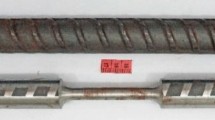Abstract
In recent years numerous studies on the high strain rate behaviour of sheet materials using split Hopkinson tensile bar set-ups have been reported in literature. For these experiments mostly dogbone-shaped specimens are used. However, widely divergent specimen dimensions can be found. In the present study the influence of this specimen geometry on the test results is investigated experimentally. An extensive series of Hopkinson tests on a steel sheet material using different specimen geometries is performed. An advanced optical technique is used to obtain the true distribution of the deformation along the length of the specimen. Important issues such as the contribution of the deformation of the transition zones to the total deformation and the (non-)homogeneity of the strain in the specimen are thus determined. From the experiments it is clear that the influence of the specimen geometry on the observed behaviour cannot be neglected. It is shown that inconsistencies between the assumed and real specimen behaviour account for these differences. For the TRIP steel considered in the study, accurate deformation values are only guaranteed if the length to width ratio of the central zone is larger than 1.25 and if the radius of the transition zone is sufficiently small.














Similar content being viewed by others
References
Itabashi M, Kawata K (2000) Carbon content effect on high-strain-rate tensile properties for carbon steels. Int J Impact Eng 24:117–131. DOI 10.1016/S0734-743X(99)00050-0.
Kawata K, Hashimoto S, Takeda N, Sekino S (1985) On high-velocity brittleness and ductility of dual-phase steel and some hybrid fiber reinforced plastics. In: Vinson JR, Taya M (eds) Recent advances in composites in the United States and Japan (ASTM STP 864). American Society for Testing and Materials, Philadelphia, PA, p 700.
Field J, Walley S, Proud W, Goldrein H, Siviour C (2004) Review of experimental techniques for high rate deformation and shock studies. Int J Impact Eng 30:725–775. DOI 10.1016/j.ijimpeng.2004.03.005.
Verleysen P, Degrieck J (2000) Improved signal processing for split Hopkinson bar tests on (quasi-)brittle materials. Exp Tech 246:31–33. DOI 10.1111/j.1747-1567.2000.tb01346.x.
Staab GH, Gilat A (1991) A direct-tension split Hopkinson bar for high strain-rate testing. Exp Mech 31:232–235. DOI 10.1007/BF02326065.
Uenishi A, Teodosiu C (2004) Constitutive modelling of the high strain rate behaviour of interstitial-free steel. Int J Plast 20:915–936. DOI 10.1016/j.ijplas.2003.06.004.
Kolsky H (1949) An investigation of the mechanical properties of materials at very high rates of loading. Proc Phys Soc B 62:676–700. DOI 10.1088/0370-1301/62/11/302.
Davies E, Hunter S (1963) The dynamic compression testing of solids by the method of the split Hopkinson pressure bar. J Mech Phys Solids 11:155–179. DOI 10.1016/0022-5096(63)90050-4.
Clark DS, Wood DS (1957) The influence of specimen dimension and shape on the results in tension impact testing. Am Soc Mech Eng Counc Rep Membersh 38:577–585.
Rusinek A, Cheriguene R, Baumer A, Klepaczko IR, Larour P (2008) Dynamic behaviour of high-strength sheet steel in dynamic tension: experimental and numerical analyses. J Strain Anal Eng Des 43:37–53.
Huh H, Kang WJ, Han SS (2002) A tension split Hopkinson bar for investigating the dynamic behavior of sheet metals. Exp Mech 42:8–17. DOI 10.1007/BF02411046.
Verleysen P, Degrieck J (2004) Optical measurement of the specimen deformation at high strain rate. Exp Mech 44:247–252. DOI 10.1007/BF02427890.
Verleysen P, Degrieck J (2004) A modified digital phase-shift moiré technique for impact deformation measurements. Opt Lasers Eng 426:653–671. DOI 10.1016/j.optlaseng.2004.05.001.
Verleysen P, Degrieck J (2003) Measurement of the evolution of the axial strain distribution in Hopkinson specimens. J Phys IV 110:501–506.
Van Slycken J, Verleysen P, Degrieck J, Samek L, De Cooman BC (2006) High-strain-rate behavior of low-alloy multiphase aluminum- and silicon-based transformation-induced plasticity steels. Metall Mater Trans A Phys Metall Mater Sci 37A5:1527–1539.
Gilat A, Goldberg RK, Roberts GD (2003) High strain rate response of epoxy in tensile and shear loading. J Phys IV 110:123–127.
Yoshida F, Uemori T, Fujiwara K (2002) Elastic–plastic behavior of steel sheets under in-plane cyclic tension–compression at large strain. Int J Plast 185–6:633–659.
Chong H, Haeng K (2001) Evaluation of mechanical properties under a temperature gradient field. Meas Sci Technol 12:1881–1885.
Eskandari H, Nemes J (2000) Dynamic testing of composite laminates with a tensile split Hopkinson bar. J Compos Mater 344:260–273.
Wang C, Xia Y (2000) Validity of one-dimensional experimental principle for flat specimen in bar–bar tensile impact apparatus. Int J Solids Struct 37:3305–3322.
Nicholas T (1981) Tensile testing of materials at high rates of strain. Exp Mech 21:177–185.
Yuanxin Z, Yuanming X (2000) Experimental study of the rate-sensitivity of SiCp/Al composites and the establishment of a dynamic constitutive equation. Compos Sci Technol 60:403–410.
Dey S, Hopperstad O, Borvik T, Clausen A (2002) Constitutive relation and failure criterion for three structural steels at high strain rates. In: Jones N, Brebbia C, Rajendran A (eds) Structures under shock and impact VII. WIT, Southampton, pp 427–436.
Hu XY, Daehn GS (1996) Effect of velocity on flow localization in tension. Acta Mater 44:1021–1033. DOI 10.1016/1359-6454(95)00228-6.
Rusinek A, Zaera R, Klepaczko JR, Cheriguene R (2005) Analysis of inertia and scale effects on dynamic neck formation during tension of sheet steel. Acta Mater 53:5387–5400.
Author information
Authors and Affiliations
Corresponding author
Rights and permissions
About this article
Cite this article
Verleysen, P., Degrieck, J., Verstraete, T. et al. Influence of Specimen Geometry on Split Hopkinson Tensile Bar Tests on Sheet Materials. Exp Mech 48, 587–598 (2008). https://doi.org/10.1007/s11340-008-9149-x
Received:
Accepted:
Published:
Issue Date:
DOI: https://doi.org/10.1007/s11340-008-9149-x




